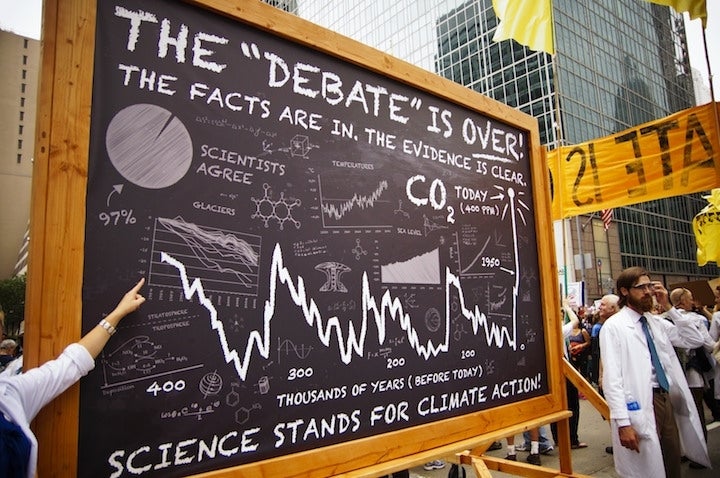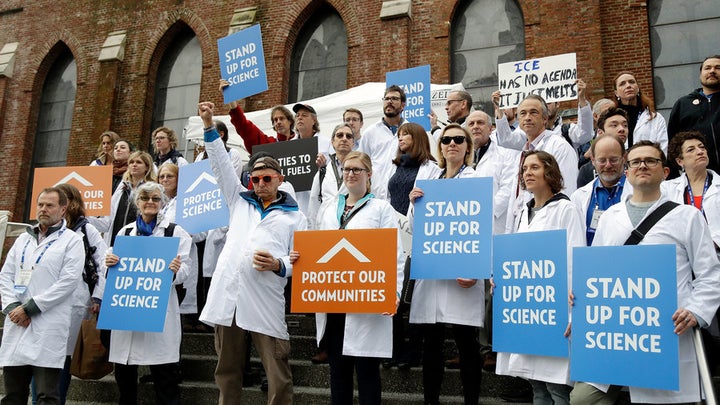This weekend, tens of thousands of people are expected to take part in the March for Science in Washington, D.C. and at over 500 satellite marches all around the world. Where I live, up in deeply nerdy Cambridge, Massachusetts, there are March for Science posters up all across the city. My Facebook feed is full of friends debating what geeky message they should put on their signs for the march tomorrow.

The debates about the March for Science go beyond what math equation looks best on a placard, however. The March has been critiqued as too elitist, too white, and unwilling to own up to the ways science has been misused as a tool of white supremacy throughout history. (To their credit, I think, March organizers have engaged in these discussions from the start and made strides in addressing a number of concerns, although there is certainly much more work to be done).
The debate that’s been most interesting for me is whether or not the March for Science is “political.” Some groups, including many of the large science associations involved in the march, have spoken of the effort as non-political. Science, they argue, is something that exists outside of politics and needs to stay there, rather than getting dragged through the mud of our political process. Others have said that the March for Science is political, but non-partisan. They want politicians of all-stripes to support science, research, and scientific literacy. Still others have said, no, this march is inherently partisan and anti-Trump. It’s the Republican party, they argue, that has made science political by joining with industry front groups to spread doubt and denial, and it’s Donald Trump’s censorship of government employees, his climate denial, and his proposed cuts to science programs at places like NASA which prompted the march.
So, which is it? Over the last decade as a climate activist, I’ve had the privilege of working with lots of scientists in all of the capacities above. We’ve used their research to inform our work, going so far as to name our organization after what scientists say is the safe upper limit of carbon dioxide in the atmosphere, 350 parts per million (we’re now well over 400ppm). We’ve also gotten arrested with them, helping coordinate protests like the first sit-ins against the Keystone XL pipeline in 2011, which former NASA climate scientist Dr. James Hansen and other scientists took part in.
In my experience, the scientists we work with are always reluctant to get engaged in politics, but get dragged into it when they see politicians actively distorting their findings, lying about their reports, or making policy decisions that run so contrary to what science tells us is necessary. They feel forced to act. Scientists get involved to help set the record straight, offer their expertise, and fight for the truth, when necessary. It’s not scientists who make science political, it’s politicians.
A good example is in the #ExxonKnew campaign, an effort to hold ExxonMobil accountable for their decades of funding climate denial and misinformation. Back in the late 1970s, Exxon scientists warned their higher-ups at the company about the threat of global warming. Instead of warning the public, executives, including our new Secretary of State Rex Tillerson, buried the truth and spent millions to spread misinformation about the issue. It was a page straight out of the Big Tobacco playbook and it cost us decades in responding to the crisis. Far from repenting for their sins, the fossil fuel industry continues to spend millions every year on climate denial front groups, and millions more lobbying against renewable energy, environmental protections, or science based policy of any sort.
All that spending has bought Big Oil plenty of friends on Capitol Hill. One of their favorite puppets has been Representative Lamar Smith of Texas, a climate denier who chairs none other than the House Committee for Science, Space and Technology. Smith is notorious for subpoenaing government science organizations like NOAA because of their work on climate change. (He’s also subpoenaed my organization, 350.org, for our work on the #ExxonKnew campaign). Earlier this year, Smith dragged out a cast of climate deniers to present to his committee. House Democrats were able to invite only one witness, Dr. Michael Mann, who did his best to set the record straight. The Scopes Monkey Trial-like hearing made headlines across the country.
The ExxonKnew case, and the political theater surrounding it, has helped convince more scientists to speak out, especially about the lies and misinformation they see being spread by the fossil fuel industry and their allies in Washington. Scientists like Dr. Mann, and scientific scholars like Harvard’s Naomi Oreskes, have become influential voices pushing back on attacks on their field. More scientists are taking to the streets, as well. At this year’s American Geophysical Union meeting in San Francisco, a “Science Stands” rally drew hundreds of participants. A few weeks later, thousands of scientists and researchers took to the streets in Boston for a similar demonstration.

It’s important and powerful to see more scientists getting involved in politics. We need their voices, speaking accurately and clearly about the challenges we face as a society, from public health to climate change. And we could use far more scientists in public office (it would be nice to have an actual scientist chair the House Science Committee, for example, rather than oily Lamar Smith).
But it shouldn’t really be up to scientists to be the ones marching in the streets. Their participation in the March for Science is fantastic, but we need our brilliant glaciologists and solar engineers to spend the majority of their time on their research, not on campaign strategy and organizing. We’re counting on them to be our warning system about what’s happening to our planet; the engineers that can help invent new, renewable energy technologies that will help solve this crisis.
Activism is the work of the rest of us. Each and everyone of us, no matter our background, can be involved in the political fight for climate action. That’s why you see so many different organizations, over 900 at the last count, coming together the weekend after the March for Science for the Peoples Climate March, a mobilization for climate, jobs and justice. From the social justice organizations like the NAACP, to international labor unions, to the nation’s largest environmental groups, movements are coming together to fight for a common cause.
In this way, the Peoples Climate March is the next step beyond the March for Science, a call to get more engaged in our political system, to confront power, and to demand solutions. It is a march that treats climate change as not only a scientific issue, but as a matter of social, economic, gender, and racial justice. The demands that we will put forward — respect for Indigenous peoples, investments in communities on the front lines of the climate crisis, moving away from fossil fuels towards 100% clean energy, and more — highlight the intersections between all of our different struggles, as well as the common solutions that we can work for together.
Solving the climate crisis, and addressing the underlying racial and social inequities that helped cause it in the first place, will take more than good science. It’s going to take activism, protest, and movement building. That’s why we need you out at the Peoples Climate March on April 29th. The breakthroughs required to address the climate crisis aren’t just in the laboratory, they’re in our political system. Getting those breakthroughs is up to us. Let’s march.
